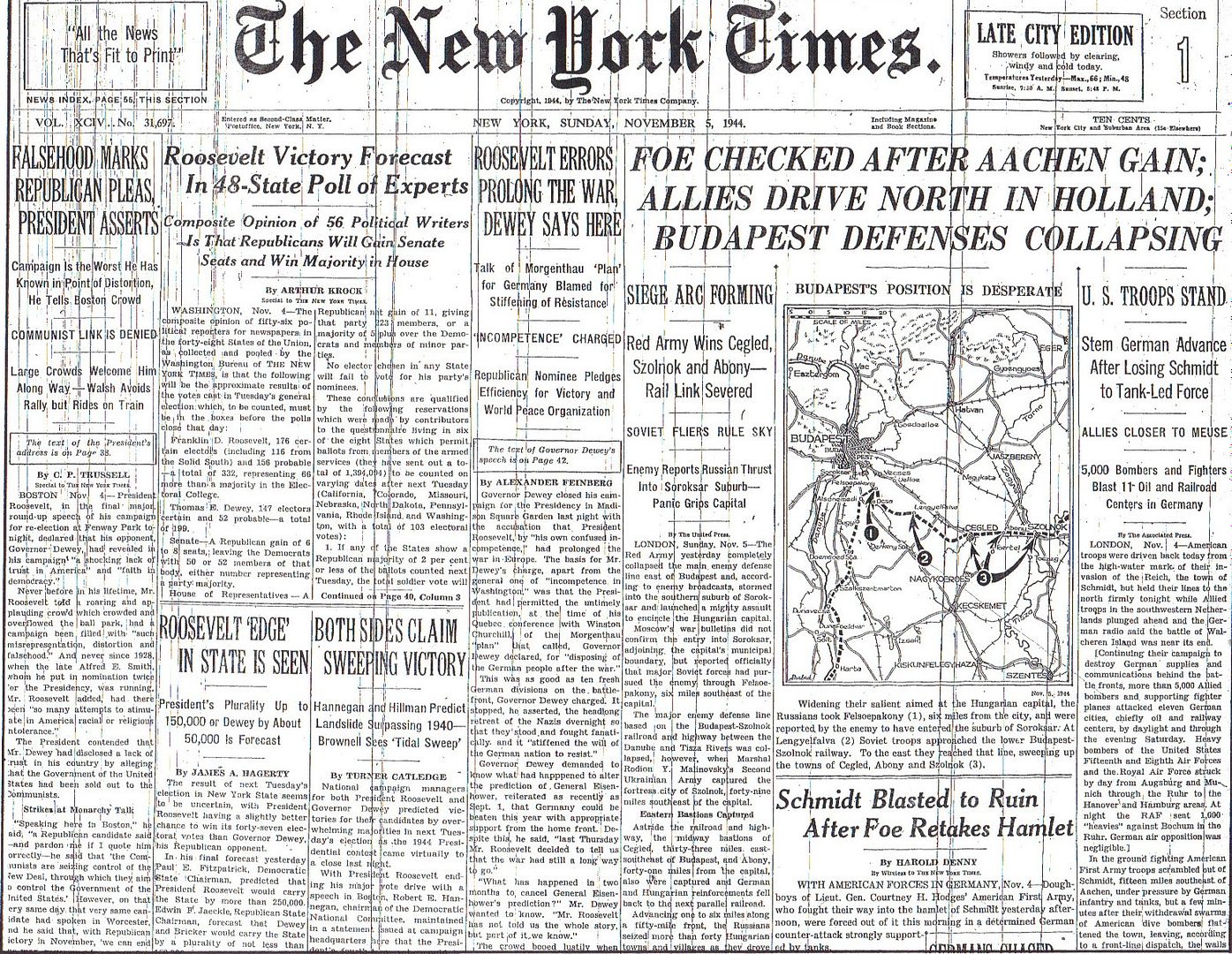
Posted on 11/05/2014 4:26:53 AM PST by Homer_J_Simpson

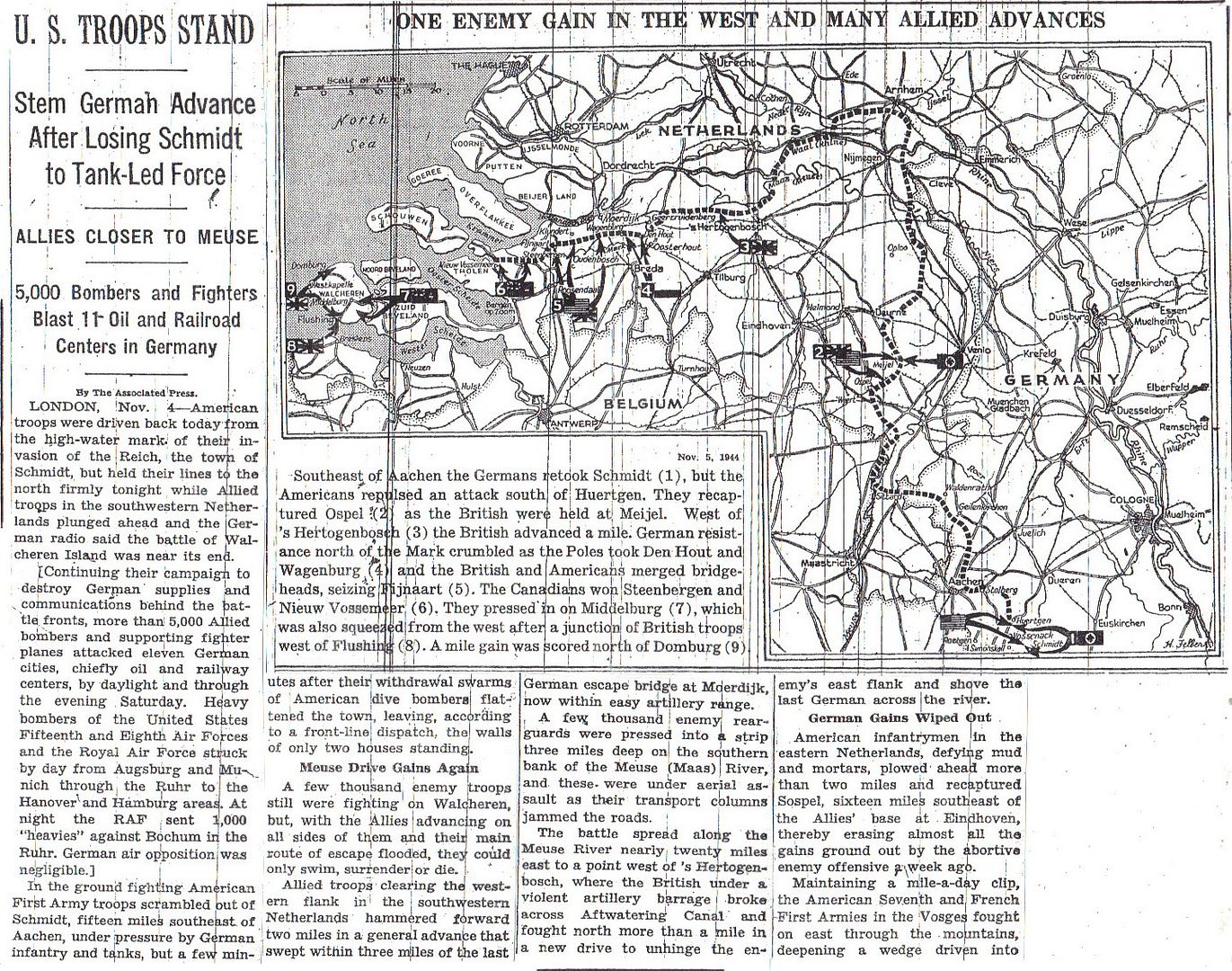
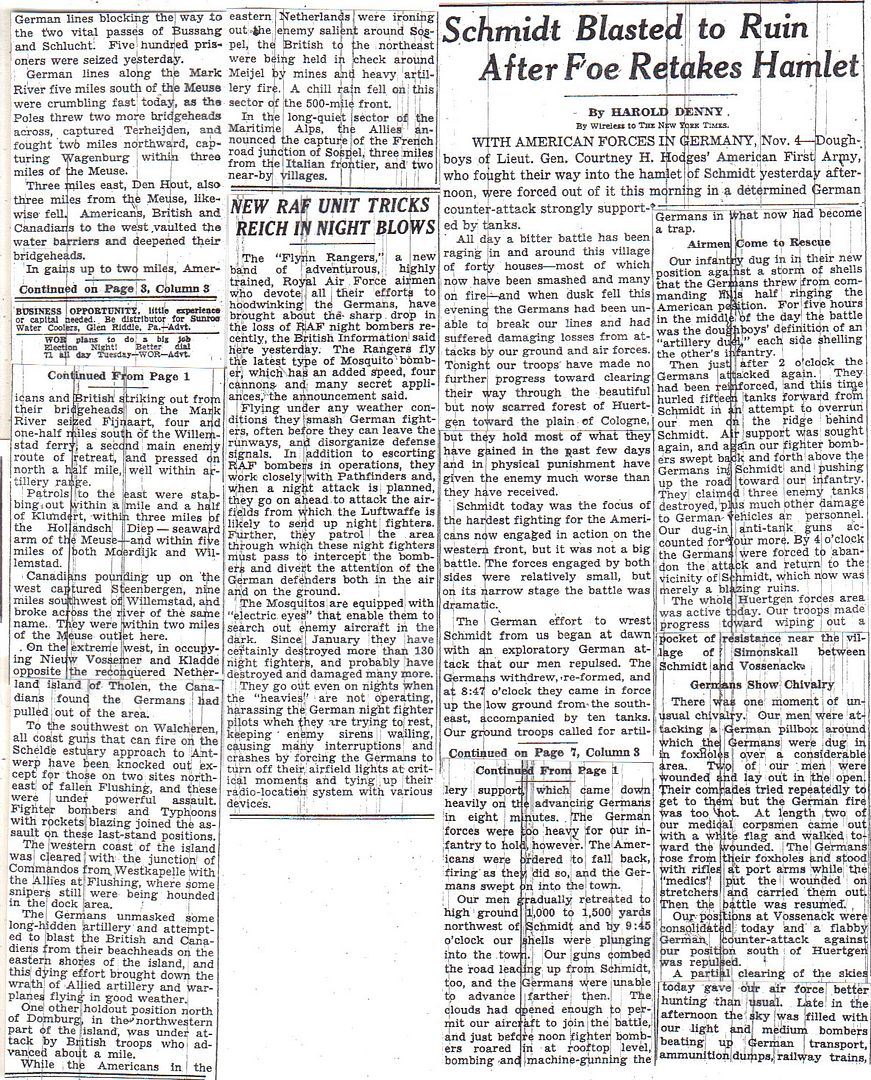
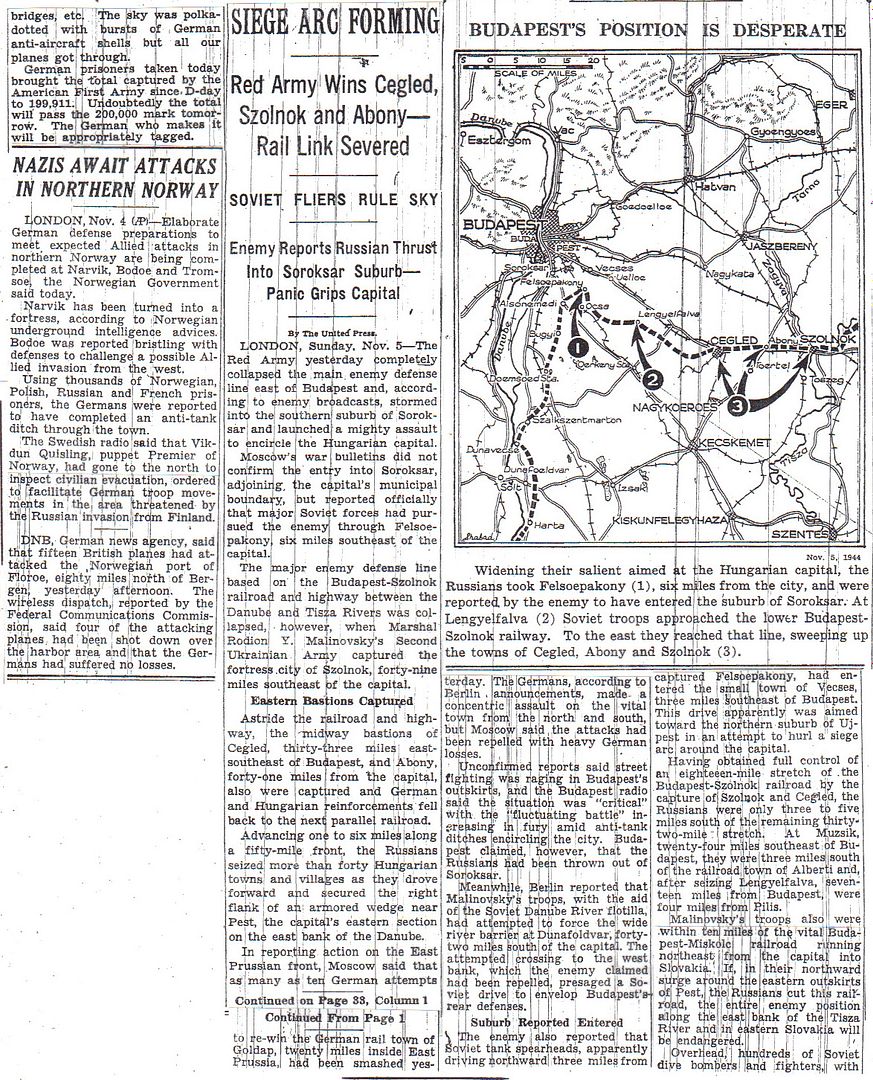
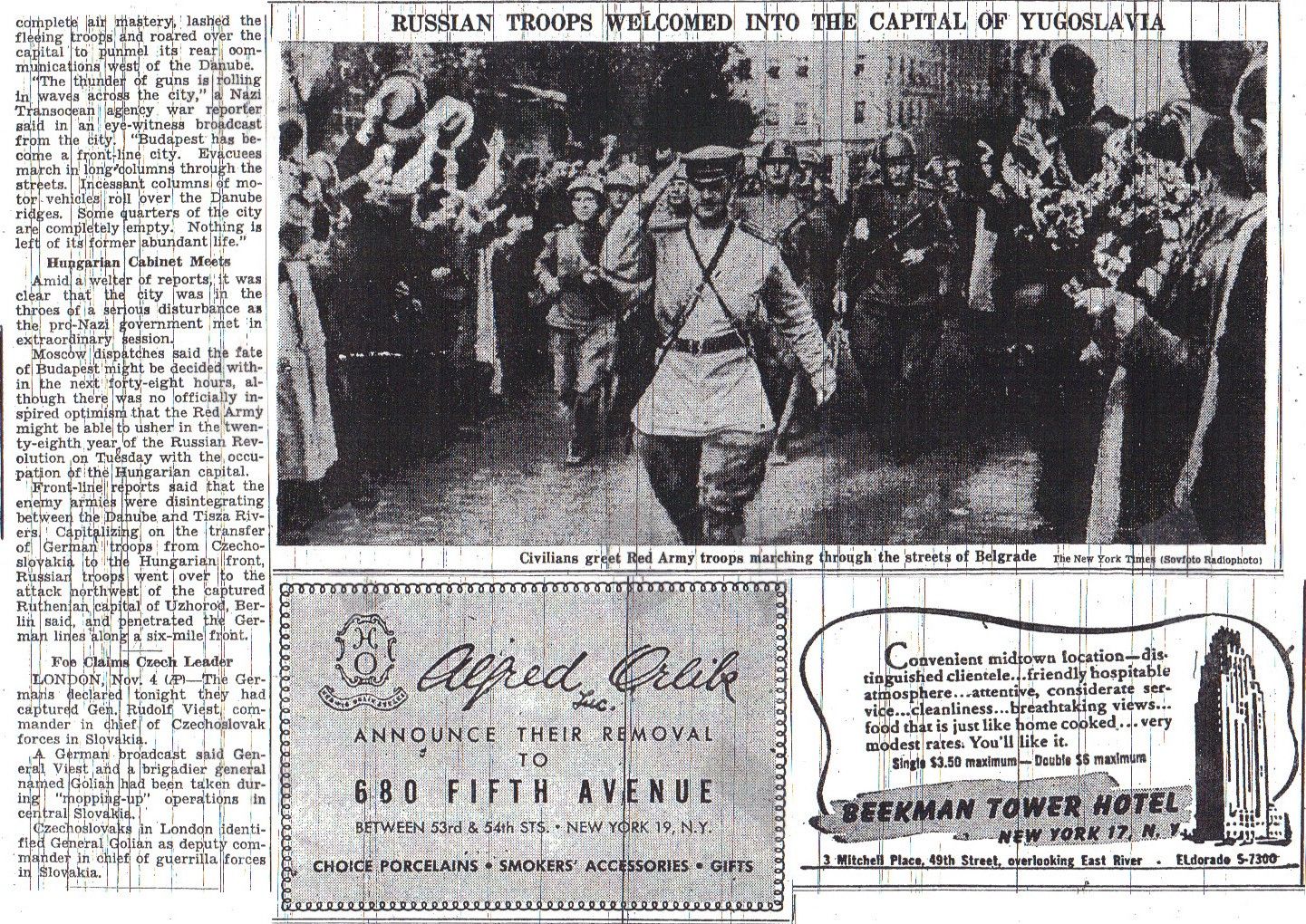
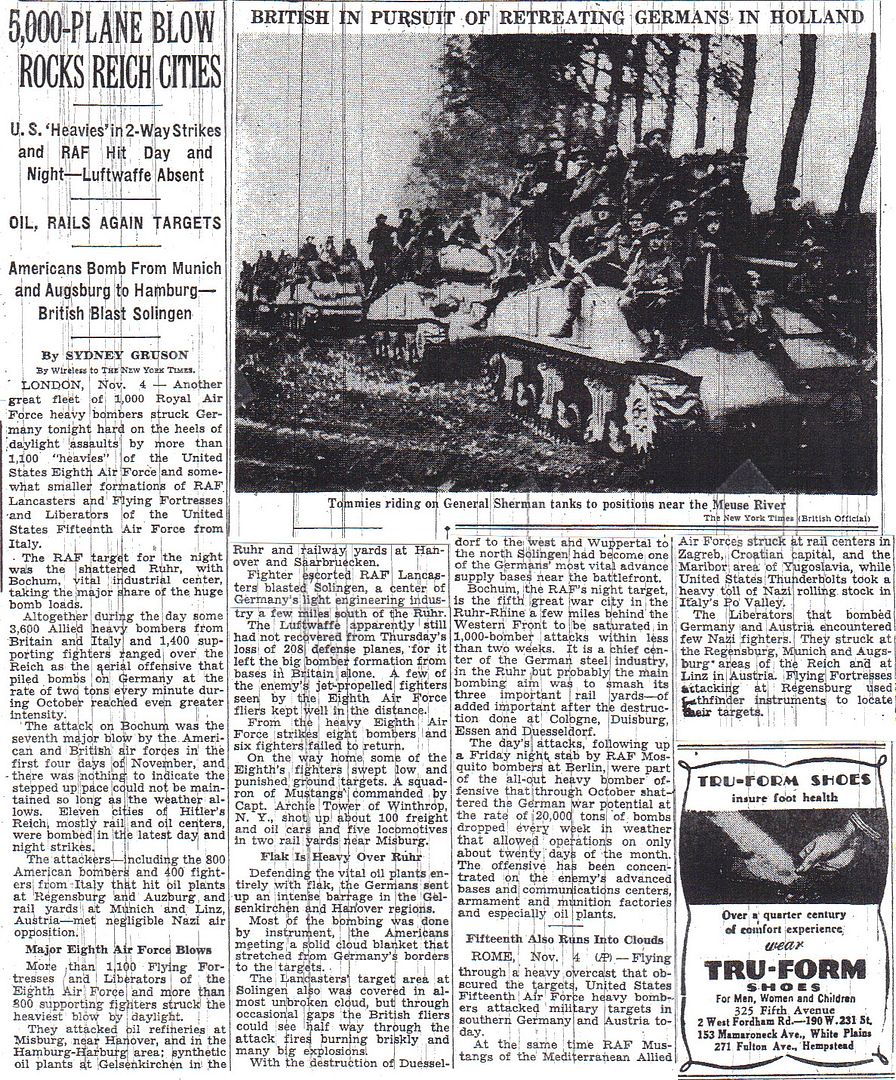
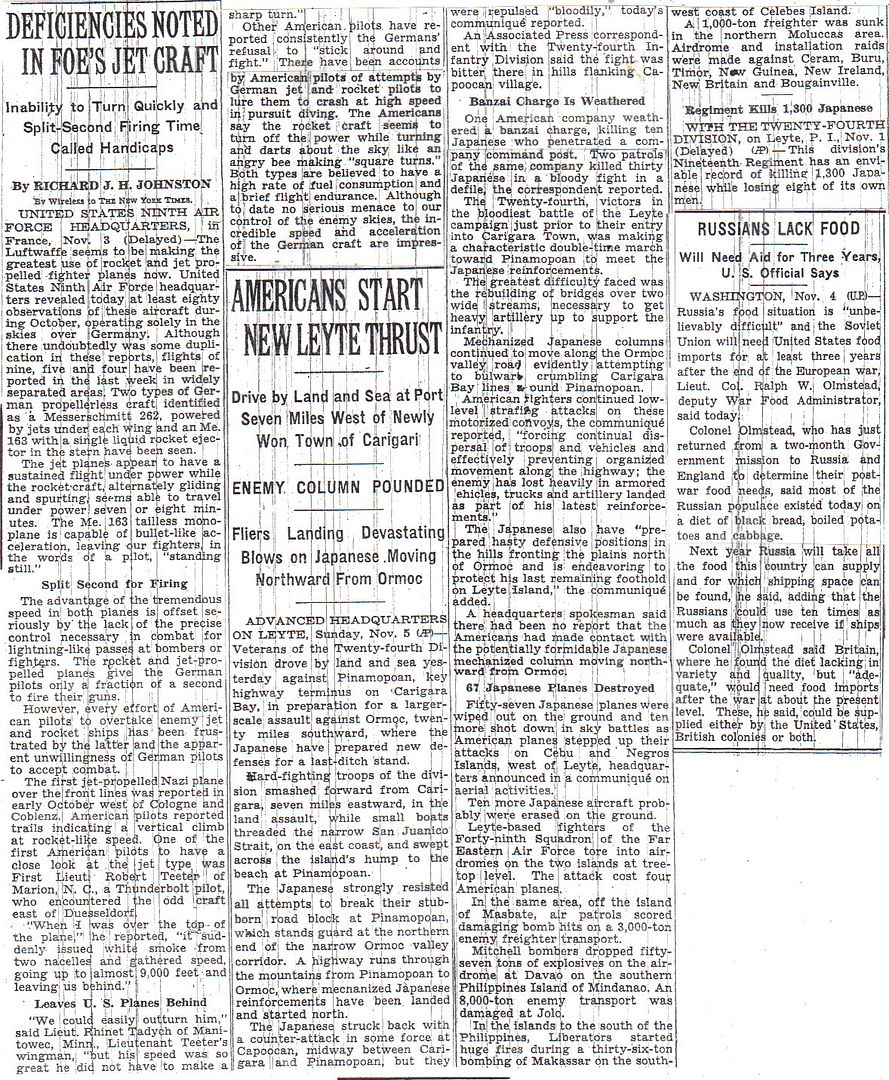
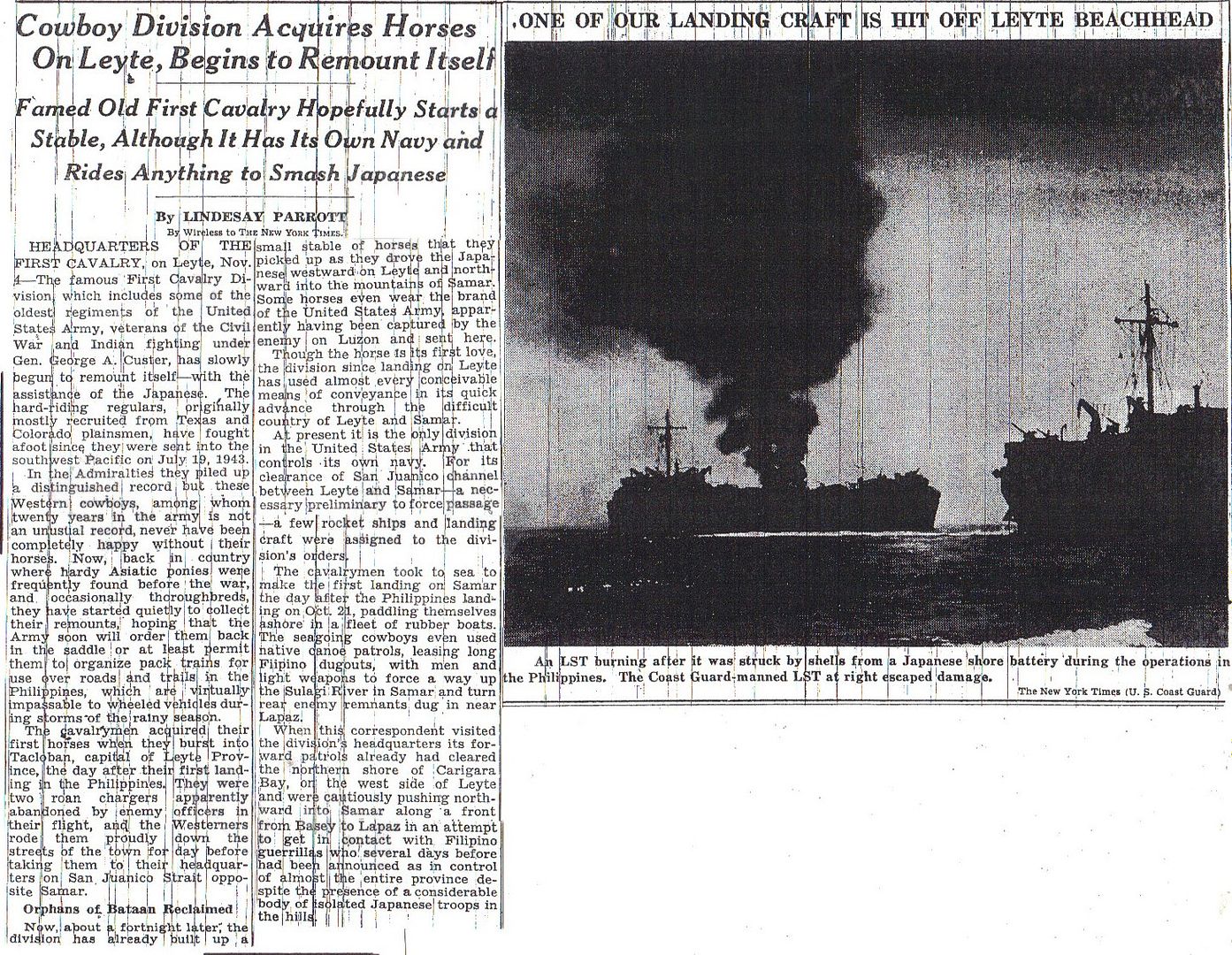
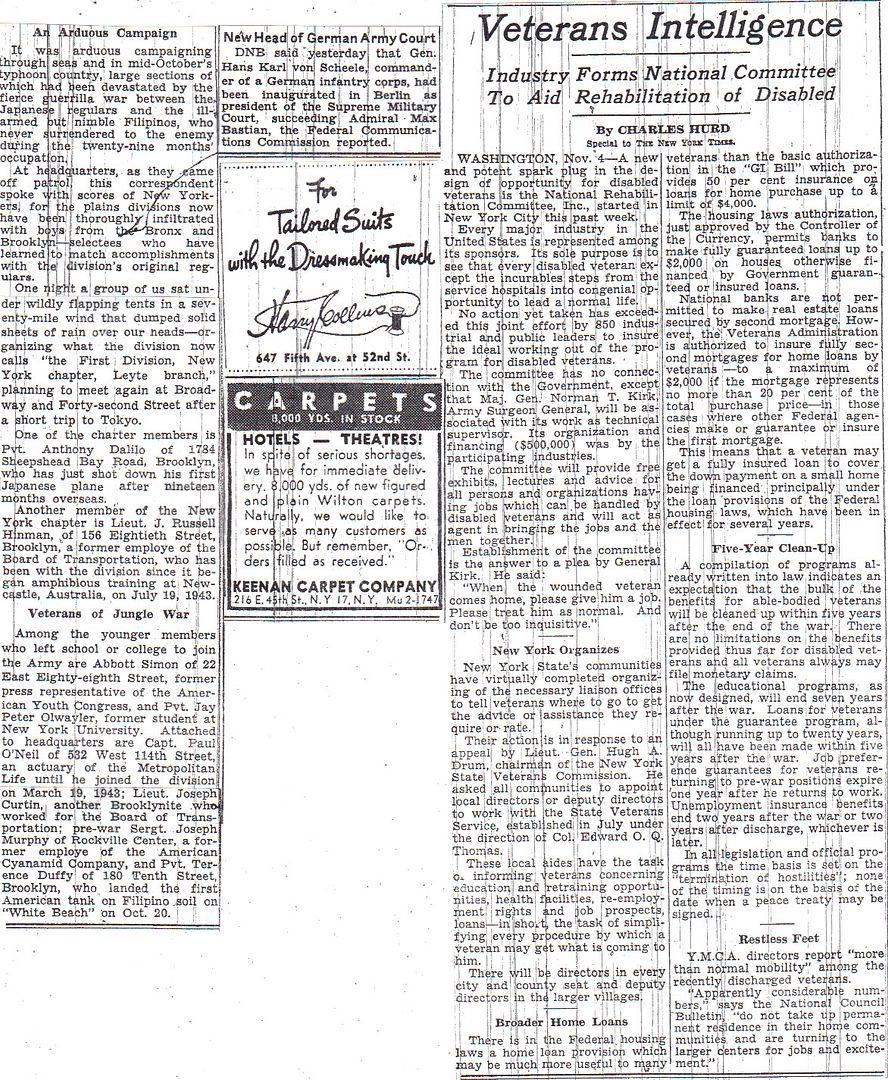
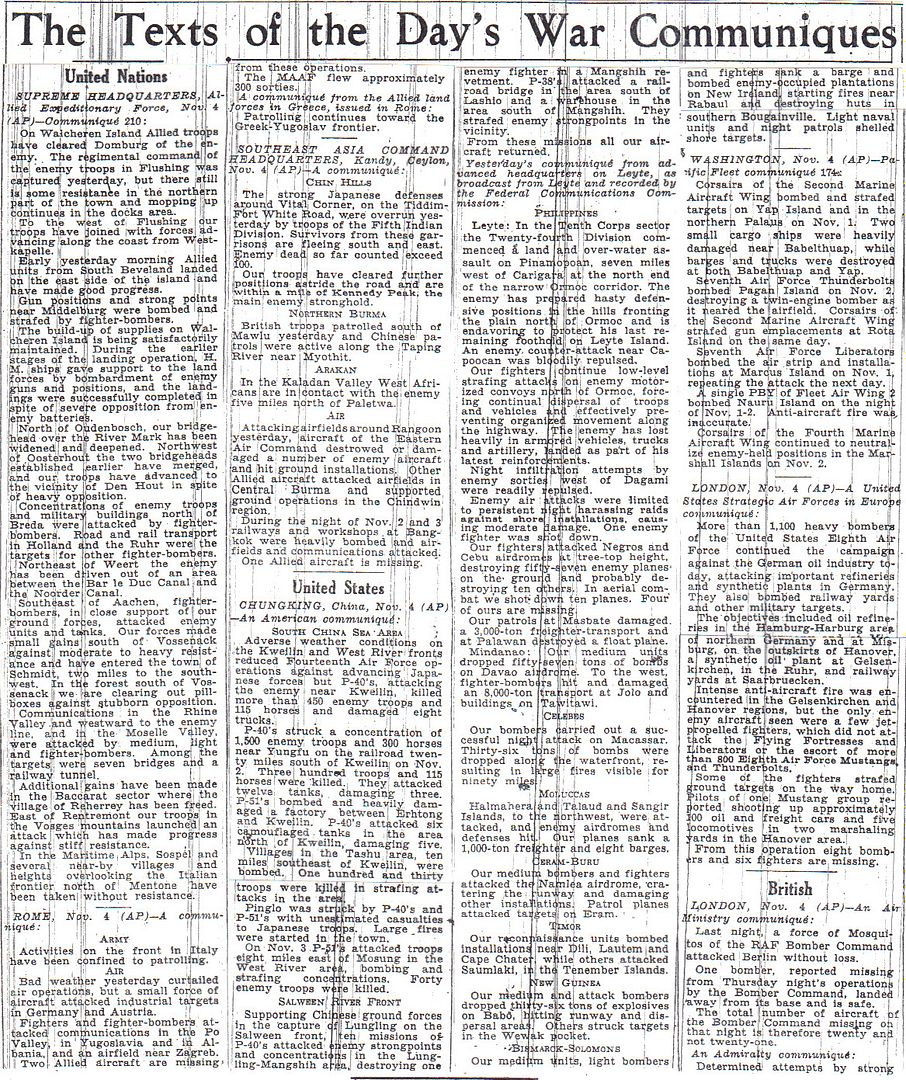
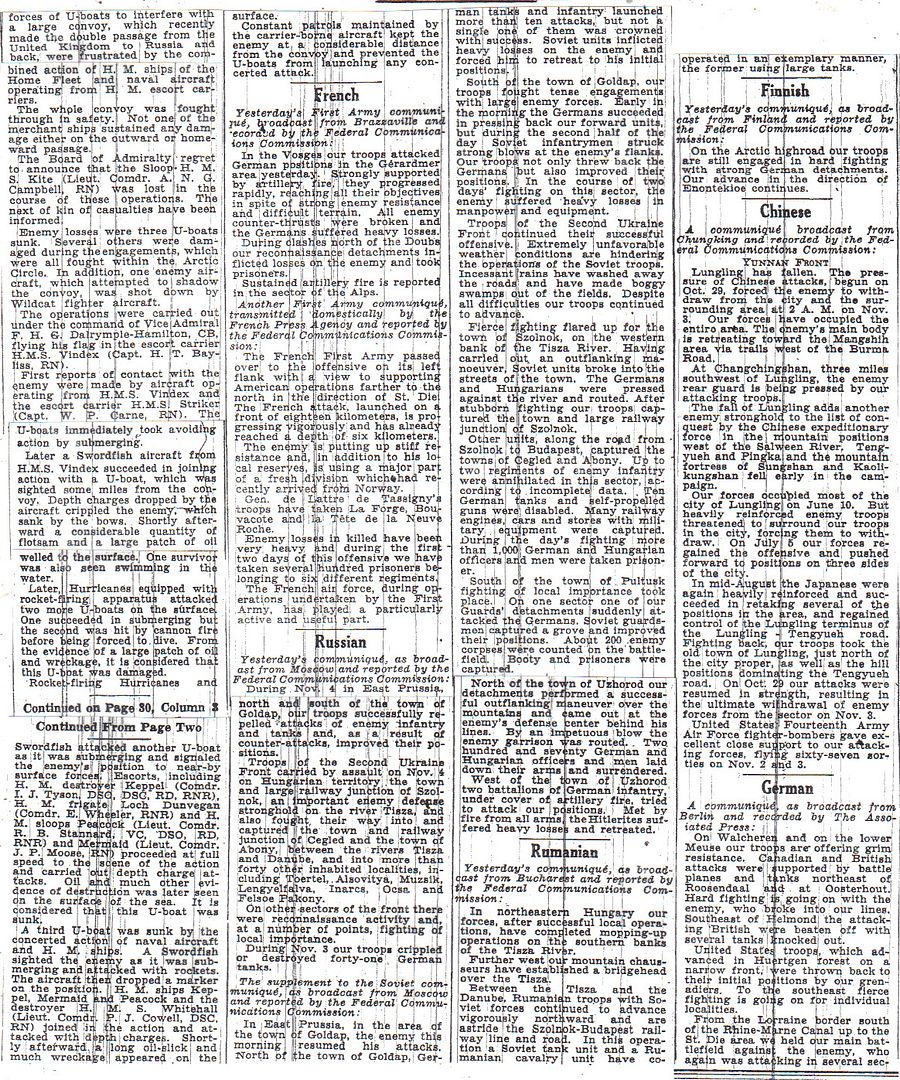
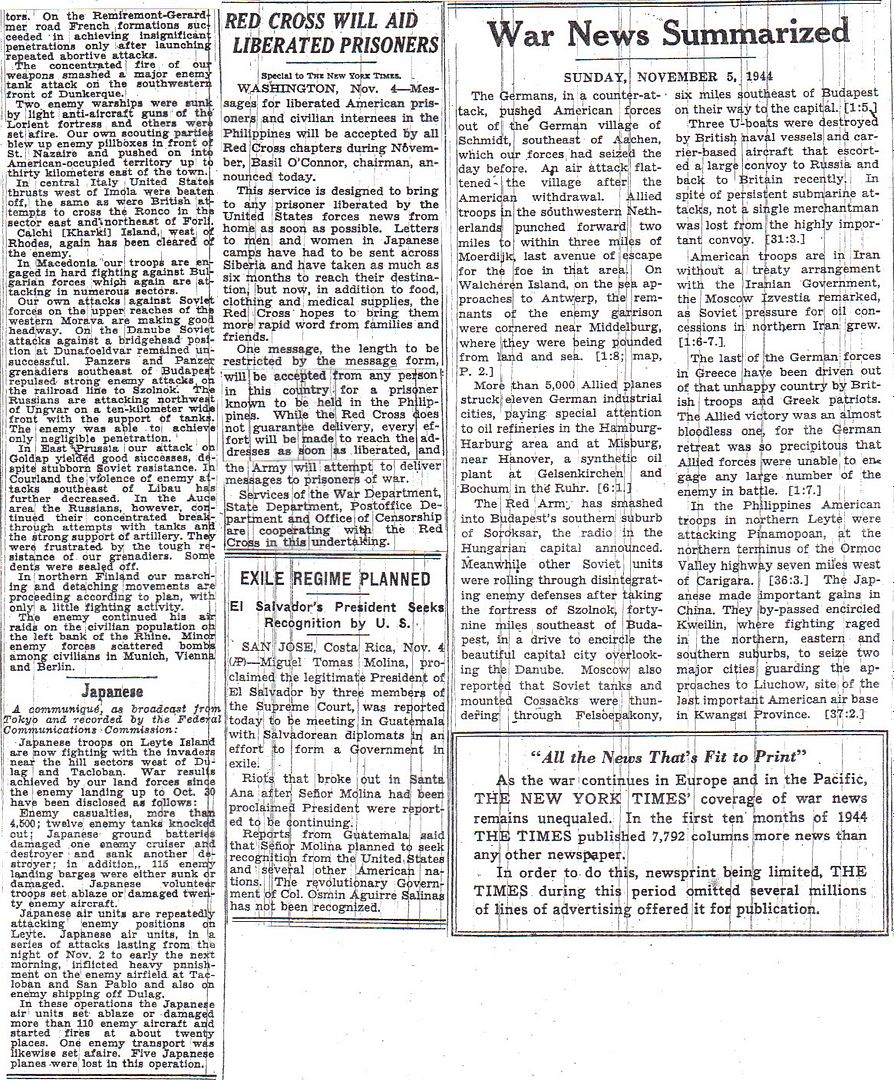
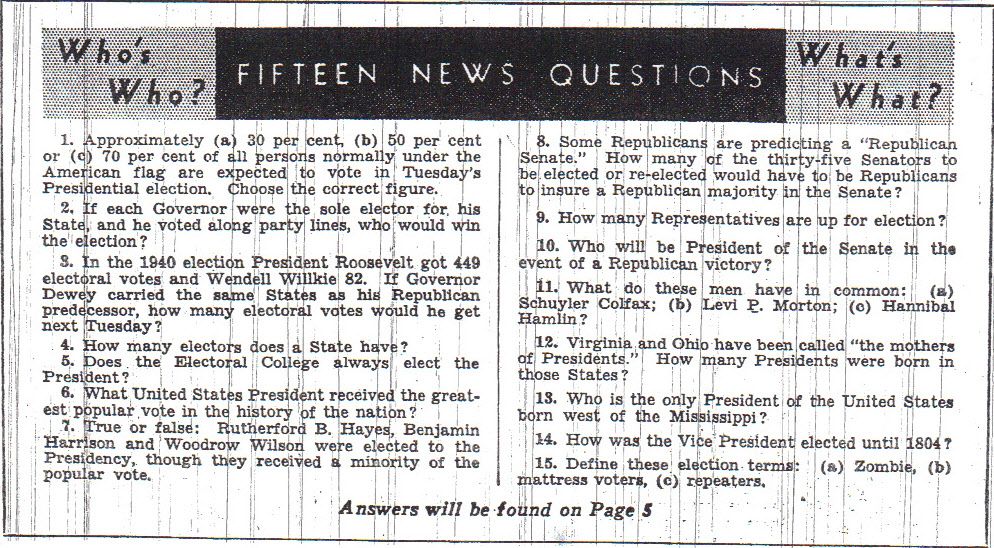
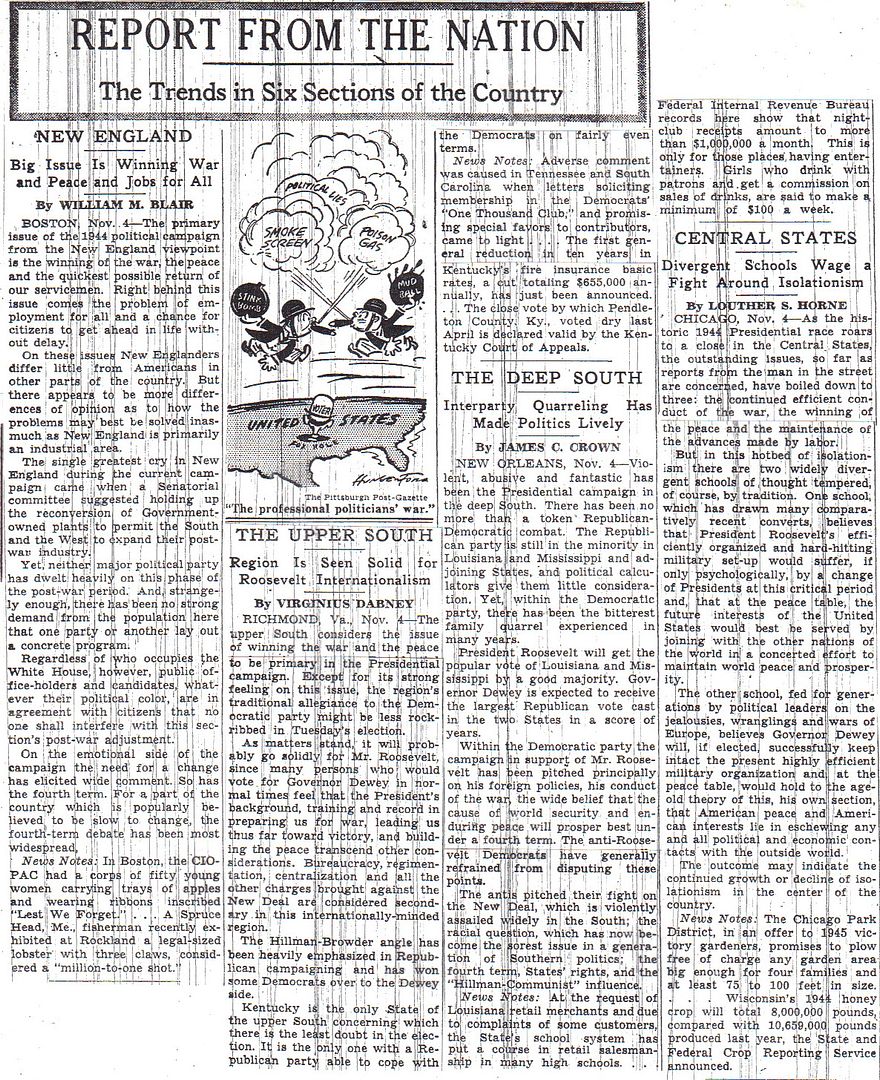
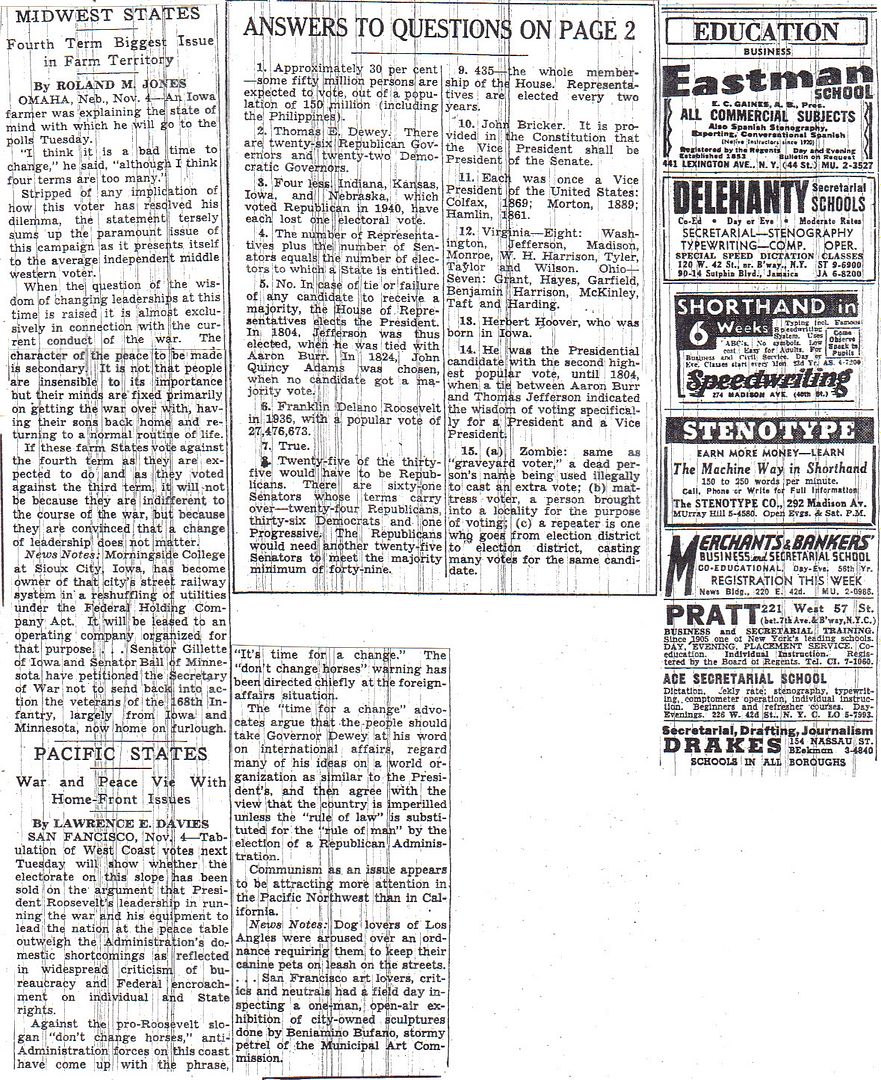

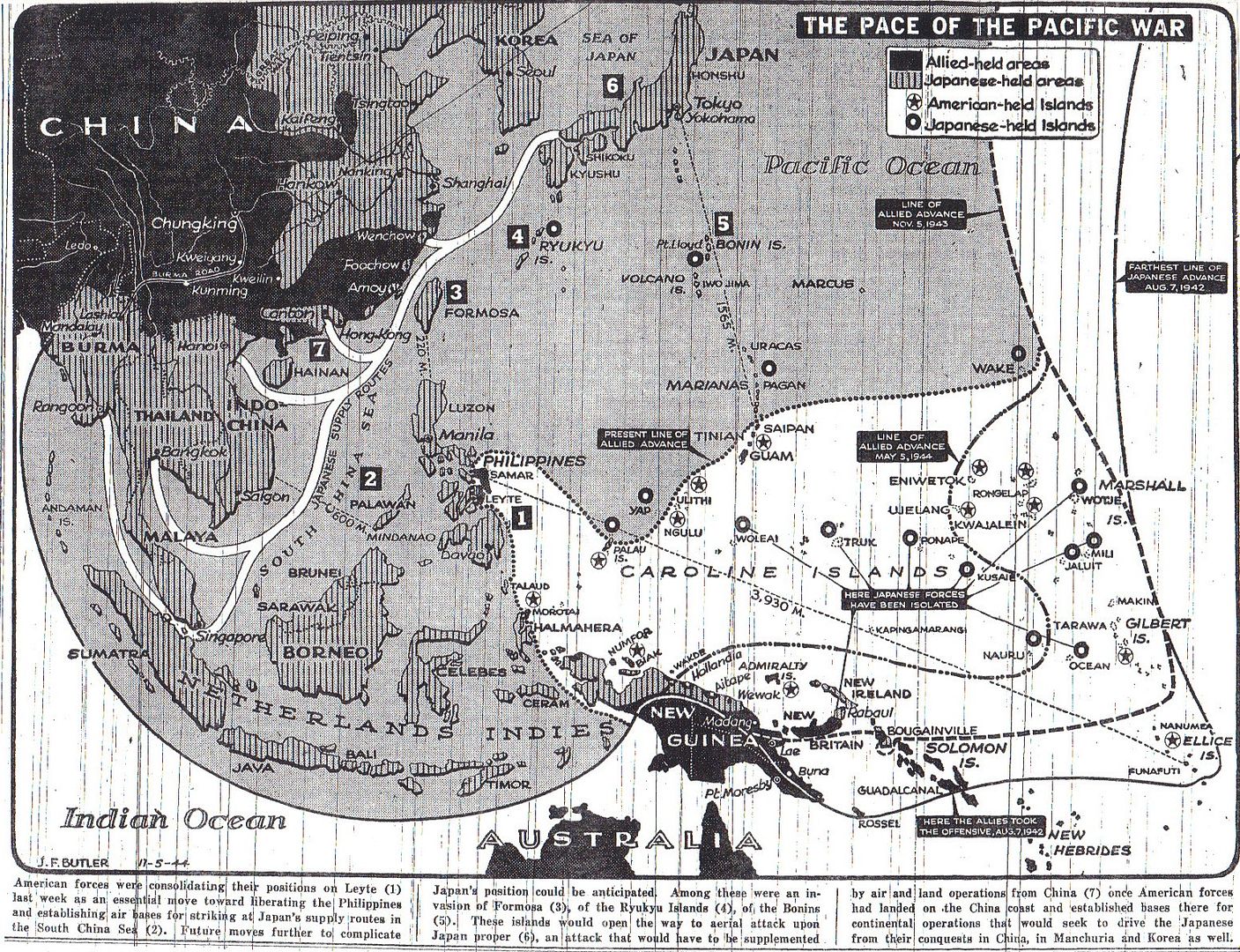
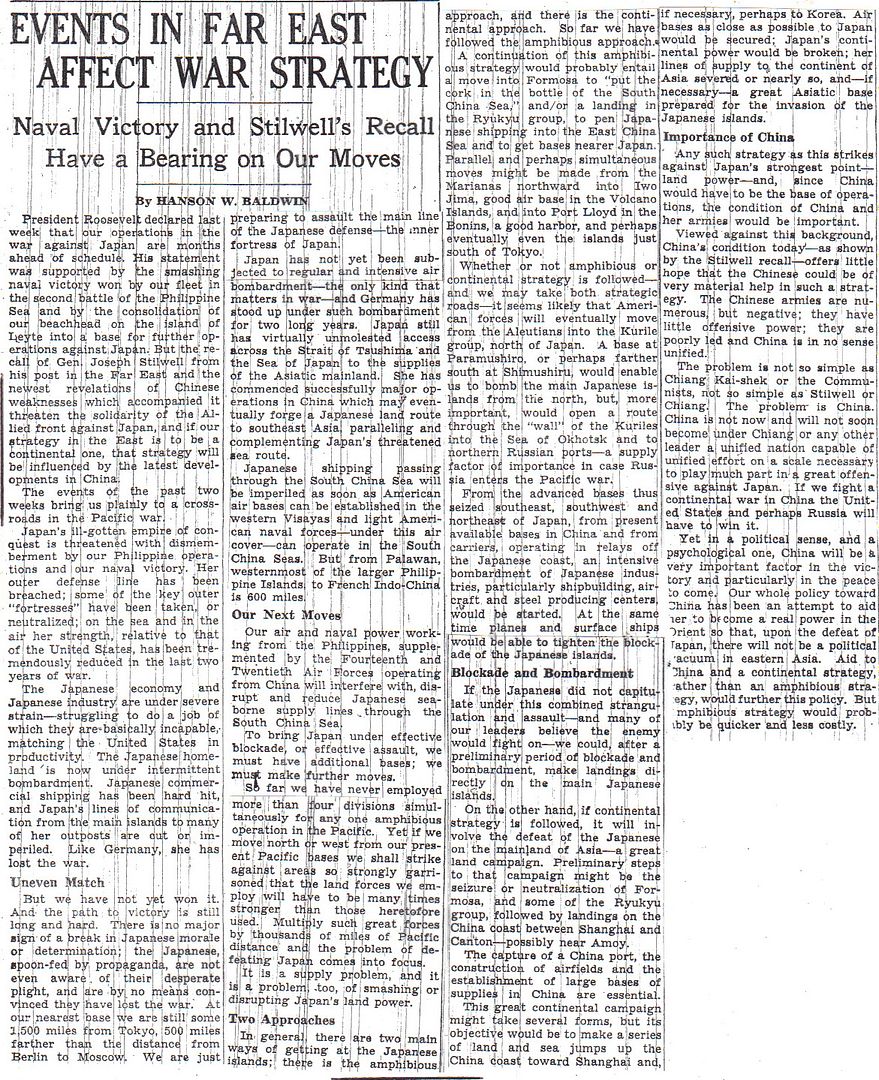
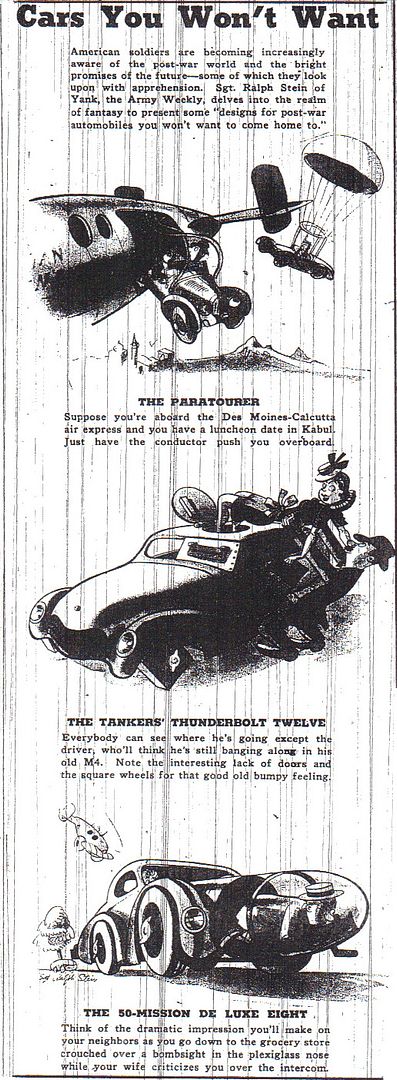
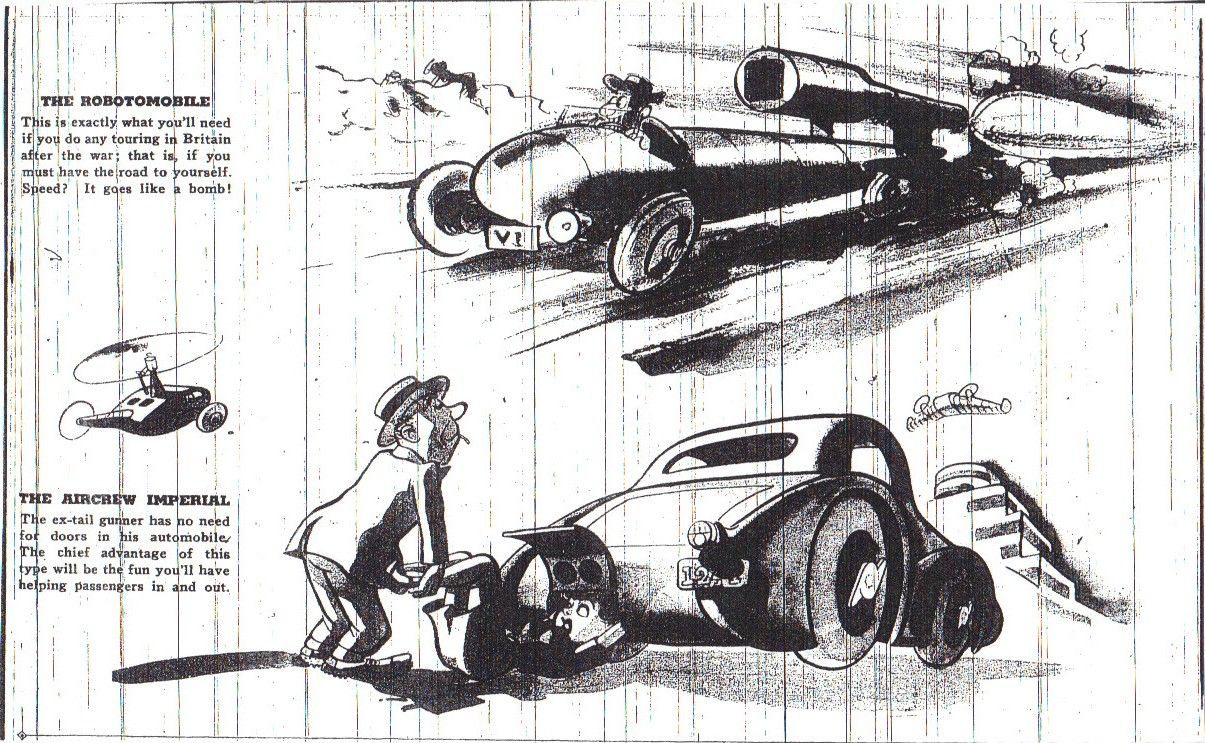

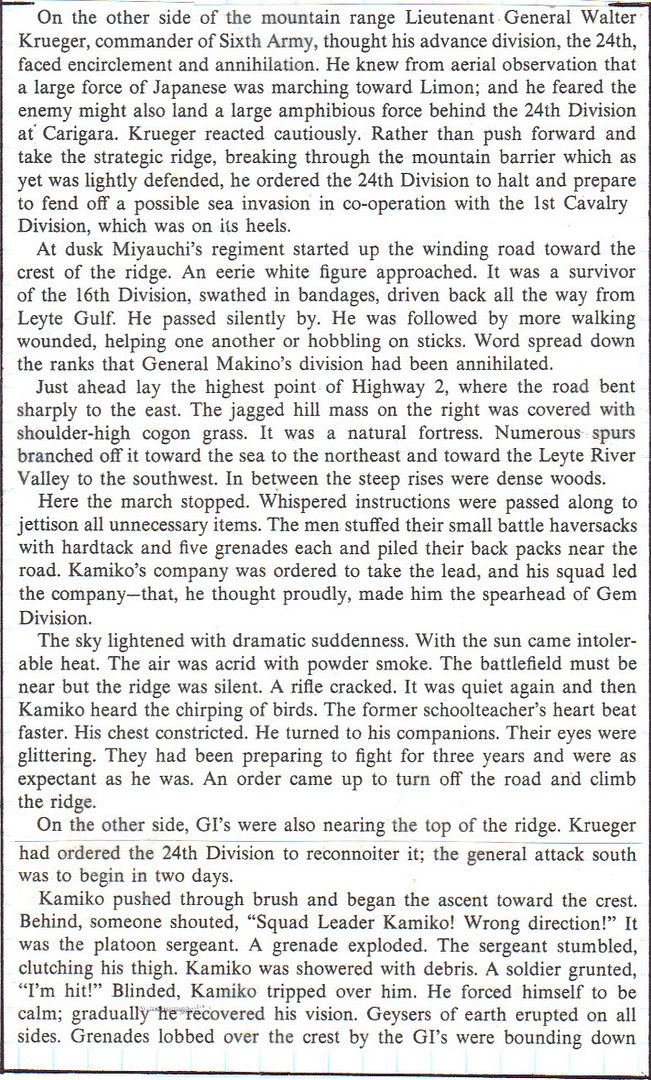
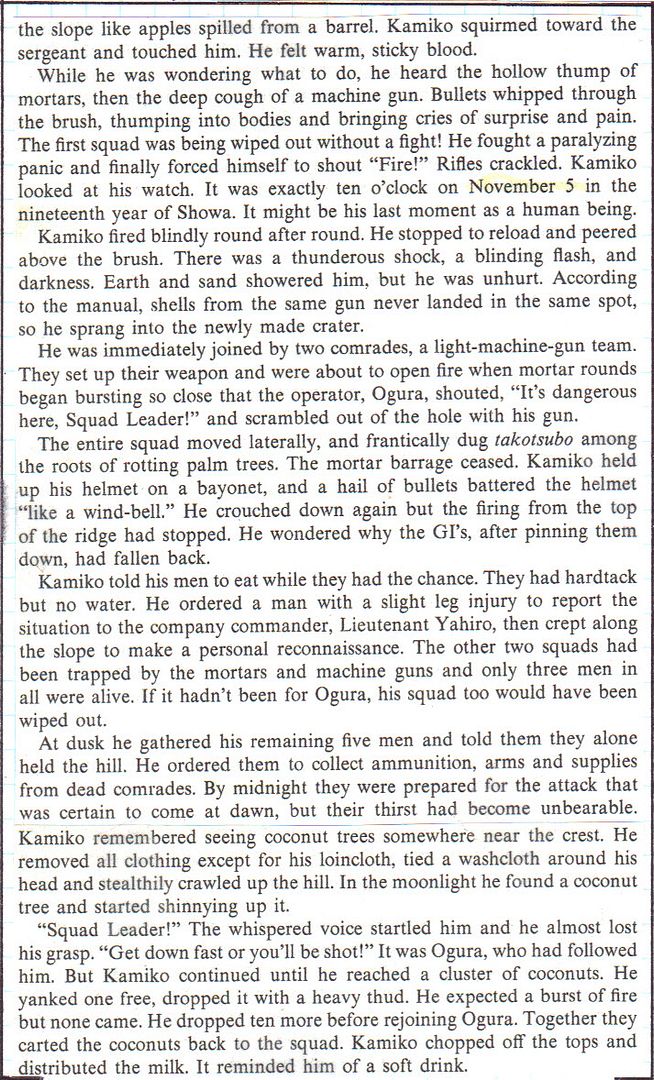
John Toland, The Rising Sun: The Decline and Fall of the Japanese Empire, 1936-1945
Just look at the vast numbers of staff units – ancillary and tail – which have been poured into Greece, and the very small proportion of fighting troops. Can we not send a few battalions of infantry? There seem to be only two there, and 1,500 ordinary British infantry out of 22,600 all told.
Winston S. Churchill, Triumph and Tragedy
The News of the Week in Review
Fifteen News Questions – 13
Report from the Nation (by William M. Blair, Virginius Dabney, James C. Crown, Louther S. Horne, Roland M. Jones, and Lawrence E. Davies) – 14-15
Answers to Fifteen News Questions – 15
Hard-Won Gains in West Speed Allied Operations (by Drew Middleton) – 16
The Pace of the Pacific War (map) – 17
Events in Far East Affect War Strategy (by Hanson W. Baldwin) – 18
The New York Times Magazine
Cars You Won’t Want – 19-20
The New York Times Book Review
In Secret Battle, by Lawrence Lipton, Reviewed by Mary Poore, first-time contributor – 21
The Best Selling Books, Here and Elsewhere – 21
http://onwar.com/chrono/1944/nov44/05nov44.htm
Air war over the Philippines
Sunday, November 5, 1944 www.onwar.com
In the Philippines... Three groups of US Task Force 38 (Admiral McCain) strike Japanese targets on Luzon and in the nearby waters. American losses are listed as 25 planes and the aircraft carrier USS Lexington is badly damaged by Kamikaze attacks. The Japanese losses are estimated at about 400 planes, 1 cruiser sunk (by an American submarine) and another cruiser badly damaged and beached.
In Greece... British forces land at Salonika.
http://www.etherit.co.uk/month/10/05.htm
November 5th, 1944 (SUNDAY)
UNITED KINGDOM: Frigate HMCS Swansea departed Londonderry for refit Liverpool , Nova Scotia.
NETHERLANDS: Heusden: Retreating Germans herd 200 citizens into the Town Hall, and then blow it up.
FRANCE: In the U.S. Third Army’s XX Corps area, the 3d Cavalry Group, after heavy fire on German positions, clears Berg and a hill to the north. The XII Corps is ready to open an offensive, but awaits order from Lieutenant General George S. Patton, Commanding General Third Army. Rain falls intermittently.
A U.S. Seventh Army directive calls for the reduction of the Germans west of the Rhine River and capture of Strasbourg. The XV Corps is to attack on D Day, taking Sarrebourg and forcing the Saverne Gap. The VI Corps, not later than D plus 2, is to attack through Vosges Mountain passes to take Strasbourg. In the VI Corps area, the 45th Infantry Division, into whose Line additional elements of 100th Infantry Division are gradually being introduced, pushes in slowly toward Raon-l’Étape. The 3d Infantry Division continues to clear the region west of the Meurthe River from the St Die area northward. The 36th Infantry Division is still engaged in Foret Domaniale de Champ.
In the French First Army’s II Corps area, the 3d Algerian Division, continuing a limited offensive toward Gerardmer, gains Rochesson, Menaurupt, and the heights near these villages.
The USAAF Eighth Air Force flies Mission 703: three B-17 Flying Fortresses and seven B-24 Liberators drop leaflets in France. .
EUROPE: In spite of Hitler’s continued promises to the German people that the so-called miracle weapons will transform their fortunes it must be plain to them that nothing but defeat stares them in the face. Why then does the German soldier continue to resist so fiercely? It is certainly not because of faith in the counteroffensive which Hitler is now planning to launch against the western Allied armies. The secrecy surrounding it is so great that only the most senior commanders are privy to the plan, and have little confidence in it.
The Waffen-SS, as the military arm of National Socialism is known, is politically indoctrinated and does include fanatics in its ranks. Indeed, this trait was clearly displayed by the 12th SS Hitler Jugend Panzer Division in Normandy. The same is not true for the bulk of the fighting forces, the Wehrmacht. The vast majority, from the C-in-C West, Field Marshal von Rundstedt, downwards, have little love for Hitler and want nothing more than for the war to end. What stops them, then, from wholesale surrender? The reasons are varied. There is, for instance, the traditional loyalty to the “Fatherland” which transcends what they might think of Hitler and his henchmen. The Allied demand for nothing but unconditional surrender is also a major factor. The German people interpret this as the wholesale destruction of the fabric of their country and hence consider that there is nothing to be gained by not continuing to fight.
Since the July bomb plot the regime has become doubly ruthless in eradicating all opposition, and fear of the consequences of disobeying orders plays its part. Above all, perhaps is the fear of the enemy in the east. Many Germans sincerely believe that Stalin and his Communists are the true threat to Europe.
GERMANY: In the U.S. First Army’s V Corps area, the 28th Infantry Division withstands infantry counterattacks against Kommerscheidt, but the Germans infiltrate the main supply route and gain control of the Kall bridge. Steady German fire on Vossenack is weakening U.S. defenders there. To help 112th Infantry Regiment in their drive on Schmidt on tomorrow, Task Force R (Colonel Ripple, commander of the 707th Tank Battalion) is formed, containing a battalion of the 110th Infantry Regiment, tanks, and tank destroyers. In the VII Corps area, poor weather conditions prevent the opening of an offensive.
The USAAF Eighth Air Force flies Mission 702: 1,272 bombers and 666 fighters in three forces attack marshalling yards (M/Ys) in western Germany; H2X radar is used by all forces; 12 bombers and six fighters are lost; 397 bombers hit Frankfurt-am-Main M/Y; 332 attack the Karlsruhe M/Y; at Ludwigshafen, 218 bomb the M/Y and 176 hit the I.G. Farben synthetic oil refinery; 36 bomb the Hanau M/Y; 33 attack the Kaiserslautern M/Y; and 19 aircraft hit targets of opportunity.
One hundred sixty USAAF Ninth Air Force B-26 Marauders and A-20 Havocs strike ammunition, ordnance, and supply depots at Hamburg; fighters escort the bombers, fly armed reconnaissance, attack railroads and bridges, and cover ground forces of the V and XIX Corps while the IX Tactical Air Command aids the US 28th Infantry Division in withstanding a counterattack near Kommerscheidt, Germany.
During the day, 170 RAF Bomber Command Lancasters carry out a G-H raid on Solingen; one Lancaster is lost. Results of the raid are not observed, because of the complete cloud cover, but German reports show that this is an outstanding success. Most of the bombing fell accurately into the medium-sized town of Solingen. 1,300 houses and 18 industrial buildings are destroyed and 1,600 more buildings are severely damaged.
During the night of 5/6 November, RAF Bomber Command Mosquitos bomb three targets: 64 hit Stuttgart in two waves and at Aschaffenburg, five attack the marshalling yard and one bombs the city.
ETO: 8th AF fighter losses:
4th FG: Lt. Russell J. Anderson, 335 FS, POW P-51D WD*U 44-14339 Hit by flak near Baden Baden.
55th FG: Lt. Gus D. Leslie, 343 FS, MIA P-51D CY*A 44-13363 “Bama blitz” Hit by flak near Eberbach.
56th FG: Lt. Robert F. Healey, 63 FS, KIA P-47D UN*R 42-76530 Ran out of fuel and bailed out over the English Channel.
Lt. Albert L. Henry, 63 FS, KIA P-47D UN*X 42-76471 Hit by flak near Neuhuetten.
359th FG: Lt. Maurice N. Haines, 369 FS, POW P-51D IV* 44-14857 “Brooklyn Devil” Hit by flak and bailed out southwest of Darmstadt. (Skip Guidry)
AUSTRIA: Five hundred three USAAF USAAF Fifteenth Air Force B-24 Liberators and B-17 Flying Fortresses bomb the Floridsdorf oil refinery at Vienna in the largest operation against a single target during World War II; three other heavy bombers bomb about three other targets.
EASTERN FRONT: German forces recapture Goldap on the borders of East Prussia. (Russ Folsom)
ITALY: In the U.S. Fifth Army’s IV Corps area, the 1st Division of the Brazilian Expeditionary Force (BEF) takes command of Combat Command B, U.S. 1st Armored Division, in place. The Corps zone, from west to east, is now manned by the U.S. 107th Antiaircraft Artillery Group, the Brazilian 1st Division, and the South African 6th Armoured Division.
In the British Eighth Army area, improving weather conditions permit Allied aircraft to begin softening up strikes in preparation for attack by the V Corps on Forli.
USAAF Twelfth Air Force medium bombers, flying 300+ sorties, bomb bridges in the Brenner Pass and in the northeast Po Valley to interdict the Germans’ two main supply routes from the north; fighters and fighter-bombers hit defenses and forces in the battle areas in the northern Apennines mountains south of Bologna and attack communications targets to the north as well as in battle zone.
GREECE: British forces land at Salonika.
YUGOSLAVIA: USAAF Fifteenth Air Force heavy bombers attack six targets: 28 bomb tactical targets at Podgorica, 14 hit tactical targets at Mitrovica, and four hit targets of opportunity.
During the day, 14 RAF bombers of No. 205 (Heavy Bomber) Group bomb the West marshalling yard at Sarajevo while 85 fly supplies to the partisans. During the night of 5/6 November, 81 other aircraft deliver supplies to the partisans.
EGYPT: Lord Moyne is assassinated in Cairo. Two members of the Zionist Stern Gang are suspected of killing the British Resident Minister in the Middle East.
CHINA: Forty nine USAAF Fourteenth Air Force P-40s, P-38 Lightnings, and P-51 Mustangs attack storage facilities and other targets of opportunity around Wanling, Burma and Mangshih, Chefang, and Kweihsien.
BURMA: About 70 USAAF Tenth Air Force P-47 Thunderbolts attack Lashio Airfield, hit gun positions on Kyundaw Island, bomb the Kanbalu marshalling yard, hit targets of opportunity along the Naba-Wuntho railroad and on the Burma Road and bomb the town of Namhpakka and the Lasai area; 28 other P-47s maintain patrols south of Myitkyina.
SINGAPORE: In the longest daylight mission ever, 53 B-29s of the US Twentieth Army Air Force based at Calcutta have bombed Singapore’s dockyards and Sumatra’s Pangkalan Brandon oil refinery, Japan’s primary source of aviation fuel - a round trip of 3,700 miles. Shonan [Light of the South], as the Japanese call Singapore, is south-east Asia’s biggest naval base. The main target was the former King George VI Graving Dock - the world’s biggest dry dock.
JAPAN: In the Kurile Islands, four USAAF Eleventh Air Force B-25 Mitchells abort an offensive sweep off Suribachi on Paramushiru Island due to intense shore fire; four more B-25s fly armed reconnaissance over Shimushu Island and at decklevel bomb Torishima Island targets; of four fighters intercepting the B-25 Mitchells, one is downed. Four B-24 Liberators bomb Onnekotan and Matsuwa Islands; three more B-24 Liberators bomb Katalka naval base on Shimushu Island, starting fires; seven fighters intercept and the B-24s down one.
MARCUS ISLAND: USAAF Seventh Air Force B-24 Liberators from Guamon an armed reconnaissance mission, bomb the island. The island is located in the North Pacific about 768 nautical miles (1 422 kilometers) west-northwest of Wake Island and is used as a refueling point for Japanese aircraft en route to the Central Pacific.
COMMONWEALTH OF THE PHILIPPINES: USN Task Force 38 (Vice Admiral John S. McCain) begins two days of carrier strikes on Luzon, targeting Japanese aircraft, airfields, and shipping. Task Group (TG) 38.3 attacks warships and auxiliaries in Manila Bay, where planes from the aircraft carriers USS Lexington (CV-16) and Essex (CV-9), and small aircraft carrier USS Langley (CVL-27) sink heavy cruiser HIJMS Nachi 5 nautical miles (9,3 kilometers) west of Corregidor Island. F6F Hellcats from TG 38.3 sink Patrol Boat No.107 [ex-U.S. tug USS Genessee (AT-55)] off Lubang Island. Navy carrier-based planes (TG 38.3 hitting targets in Manila Bay, TG 38.1 targets off Santa Cruz) damage destroyer HIJMS Akebono and escort destroyer HIJMS Okinawa, landing ship HIJMS T.111, a motor sailship and two cargo ships. During Japanese retaliatory air strikes on the aircraft carrier USS Lexington (CV-16) located about 202 nautical miles (375 kilometers) east-northeast of Manila, Luzon, Philippine Islands, a flaming Japanese plane cr ashes near her island, destroying most of the island structure and spraying fire in all directions. Within 20 minutes major blazes are under control, and she is able to continue normal flight actions. Between 0625 and 1700 hours, carrier-based fighters shoot down 97 Japanese aircraft at sea and over Luzon, especially near Clark Field.
In the X Corps area on Leyte Island, the 1st Cavalry Division begins a prolonged program of patrolling in the central mountains. In the XXIV Corps area, the 382d Infantry Regiment of the 96th Infantry Division continues an attack on Bloody Ridge after artillery preparation and, with assistance of a company of tanks, is reducing the Japanese positions there.
USAAF Far East Air Forces B-24 Liberators and P-40s attack airfields and barges in the central Philippine Islands.
EAST INDIES: In the Netherlands East Indies, USAAF Far East Air Forces B-24 Liberators hit the town of Bima and Waingapoe Bay shipping on Soembawa Island in the Lesser Sunda Islands. B-25 Mitchells and fighter-bombers strike airfields, troop concentrations, and communications targets throughout the Halmahera Island area and northeastern peninsula of Celebes Island. Fighter-bombers and A-20 Havocs hit Amahai and targets of opportunity on a small island, south of Ceram.
Seven Calcutta, India-based B-29 Superfortresses of the USAAF Twentieth Air Force’s XX Bomber Command bomb the Pangkalanbrandan refinery on Sumatra, Netherlands East Indies while four more hit other target.
NEW GUINEA: In Dutch New Guinea, almost 50 Far East Air Forces A-20 Havocs, supporting ground forces, blast installations in Sarmi, New Guinea area.
BONIN ISLANDS: USAAF Seventh Air Force B-24 Liberators from Guam hit shipping in the islands.
VOLCANO ISLANDS: Iwo Jima: Twenty four B-29s of the USAAF Twentieth Air Force’s XXI Bomber Command attack the two airfields on a training mission, starting the tactical operations against the island in preparation for the U.S. invasion in February 1945.
PACIFIC OCEAN: A U.S. Navy patrol boat spots a Japanese Fugo balloon bomb floating on the water 66 nautical miles (122 kilometers) southwest of San Pedro, California. The Navy recovers some apparatus, envelope, and rigging.
U.S.A.: Top songs on the pop record charts are: “I’ll Walk Alone” by Dinah Shore, “Dance with the Dolly” by The Russ Morgan Orchestra with vocal by Al Jennings, “How Many Hearts Have You Broken” by The Three Suns, and “Smoke on the Water” by Red Foley.
Submarine USS Cutlass launched.
The German map for Aachen. The broken line southeast of Aachen is the sector of confused fighting in the Hurtgen Forest and around Schmidt. The description of the 1st Battle for Schmidt does not accurately portray the rout of the battalion of the 28th Infantry Division sent to take the town.
German map for the Ardennes:
German map for Lorraine:
Fugo balloons:
http://en.wikipedia.org/wiki/Fire_balloon
http://www.stelzriede.com/ms/html/mshwfugo.htm
I could use some FUBO balloons.
Anticipating the upcoming Battle of the Bulge: Do you know if anyone on the Allies’ side actually predicted an all-out German winter offensive on the western front? If so, did anyone get either the date or location correct, even roughly? I recall the ‘Patton’ movie attributed such a prediction to him, but was it in fact true of anyone?
The short answer is yes, some intelligence officers predicted a German winter offensive, but not with great exactitude. When I check my sources at home this evening, I will provide more detail.
Thanks!
My memory says that it was Patton’s intelligence people who warned of a German attack in the Ardennes.
The First Army G-2 Col. “Monk” Dickson probably came closest to predicting the Ardennes offensive. He had the number of divisions about right but was looking at north of Aachen IIRC.
There was quite a bit of intel that was available to twig the Allies that something was in the works but I think the Allies were convinced that the Germans were beaten.
Also the German security measures were very effective as none of the rank and file soldiers were even aware of the offensive until just before the attack began.
If you can get hold of “a Time for Trumpets” by Charles MacDonald one of the very first chapters deals with the intelligence efforts of both the Allies and the Germans
Regards
alfa6 ;>}
Thanks alfa6. I knew of Col. Dickson, but couldn’t recall his name. “Monk” Dickson was the real life person who was the “inspiration” for the character played by Henry Fonda in that wretched war movie “Battle of the Bulge.” Of the 5 five worst war movies of all time, ever, I think Battle of the Bulge accounts for three of them.
Being on their home soil aided German secrecy. There was no “underground” or network of allied agents to pass along information regarding troop movement and deployment. Also, the Germans relied more on land line telephone for comunication and less on radio, so that there was not as much radio traffic and resulting ULTRA decrypts.
I’ll check my copy of Time For Trumpets but I don’t think Patton predicted the attack in the Ardennes. Instead, he realized more quickly than the rest of the allied command exactly what was happening, and had his staff working on the counter-attack plans before he left for the command conference at Rheims. Of course, my memory could be bad and I really should consult authority before typing.
Patton did expect an attack but I don’t think he was expecting it in the Ardennes. I think that was in “A time for Trumpets” in the intel chapter as well. I will try to look at it tonight as well.
The story I recall about Patton was having his staff start planning for several different attacks depending on what the big meeting with Ike decided a couple of days after the Bulge started.
Patton was all for letting the Germans get to Paris so they could really cut them up but Ike wouldn’t allow it.
Regards
alfa6 ;>}
Alpha6, thanks for pointing me back to MacDonald’s “Time For Trumpets.” Wow. I had forgotten how good that book is. Anyway, to sum up Chapter 3, What Did The Allies Know:
1. The Allies intercepted Hitler’s order in September to pull all the panzer and panzergenadier divisions out of the line for reconstitution
2. The allies in fact noted that most of the German panzer units had been pulled out of the line
3. The allies knew the Germans were concentrating the panzer reserves in the northern Eifel area across from American VIII Corps in the Ardennes
4. Until early December, the general consensus was that the Germans were most likely holding these divisions for a counter-attack, or in the less likely alternative, planning a limited spoiling attack in the Aachen area
5. The information contained above was known to all Allied intelligence officers at SHAEF, 12th Army Group, 1st Army and 3rd Army. And the consensus was held by all of them
6. It was only in the first week of December that it begn to dawn on allied intelligence offices that the Germans could lauch an offensive in the Ardennes
7. Bradley was sufficiently concerned that he got Ike’s consent to send the newly arrived 9th Armored Division to VIII Corps and engage in some deception to get the Germans to believe the 75th Infantry Division was in the area (it was still in England).
8. Patton first began to worry about the Ardennes on Nov. 24, but the real red alert was raised by Patton’s G2, Col. Koch, who held a briefing for Patton and his staff on December 9. Koch outlined the attack that was about to happen, although he thought it was meant to spoil Patton’s Saar offensive.
9. Patton was determined to proceed with the Saar offensive, but did order the preliminary planning for contingencies should the German attack take place. And this was what allowed Patton to start his counterattack so quickly.
10. The last guy to realize the danger was Middleton at VIII Corps, but when he did, he asked for reserves but Bradley had none to give.
11. Monk Dickson’s final intel report on the eve of the attack was not well written or focused. He was still not sure whether there would be an attack or a counterattack.
It appears that the Americans knew a good deal about German dispositions, but didn’t have a good grasp of their intentions. When they did start to figure it out, it wasn’t with a complete grasp of what was going to happen, there was no consensus among the intelligence officers, and it was too late to do anything anyway.
Actually, there are many similarities btween the intelligence failures in the Ardennes and Pearl Harbor.
My original reason for asking earlier today was the principle of contingency planning. In this case, shouldn't SHAEF (1) identify the possible enemy actions that would potentially be most hazardous to Allied success and (2) guard against them? At least Patton seems to have planned, anyway--so the movie was roughly accurate on that point.
It seems like if you know the Germans have stripped their defenses of substantial panzer units, you'd want to do likewise in order to create an adequate mobile reserve to counter them. But then, I'm just an ignorant desk soldier....
Disclaimer: Opinions posted on Free Republic are those of the individual posters and do not necessarily represent the opinion of Free Republic or its management. All materials posted herein are protected by copyright law and the exemption for fair use of copyrighted works.